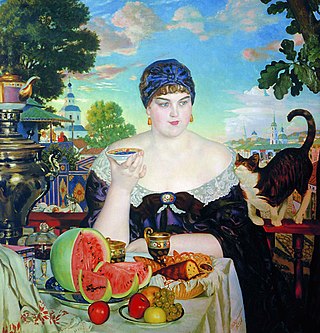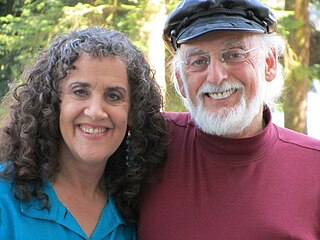
Newlyweds are people who have recently entered into a marriage. The time frame during which a married couple is considered newlywed varies, but for social science research purposes it may be considered as up to six months into the marriage. [1]

Newlyweds are people who have recently entered into a marriage. The time frame during which a married couple is considered newlywed varies, but for social science research purposes it may be considered as up to six months into the marriage. [1]

Researchers generally contend that "early in marriage, newly married couples are affectionate, very much in love, and relatively free of excessive conflict, a state that might be called 'blissful harmony'". [2] The "high levels of love and commitment" experienced by newlyweds "are relatively stable during the first year of marriage". [1] The marital relationship (as opposed to other familial relationships, friendships, or work relationships) is the most important relationship in causing happiness in newlyweds. [3] Perhaps counter to expectations or stereotypes, erotic love is not a major factor in the happiness of many newlyweds. [4] Newlyweds experience a "happiness boost" that lasts for the first two years of marriage on average, with happiness levels then returning to pre-marriage levels. [5] Many newlyweds experience feelings of elation, an increase in self-esteem, and a more secure attachment style after the start of their marriage. [6]
Many newlyweds, especially in Western cultures, take a vacation in the immediate wake of the wedding, known as a honeymoon. The honeymoon is part of the wedding ritual in Great Britain and the United States. [7]
Newlyweds may face significant stress as they work to integrate their individual lives into a newly combined social, financial, and legal status. This stress can lead to biological alterations, with endocrine changes found in newlyweds who exhibit hostility in laboratory settings. [8] In some cultures, "[n]ewlyweds are expected to earn a living independent of their parents' help", [9] while in others, the new couple are expected to integrate into the household of one of their parents while working to gain the means to establish their own household. [10] Newlyweds' perception of their integration into their new family can be affected by the amount and type of information conveyed to them by their in-laws. [11] Even when newlyweds in the United States report a positive relationship with their spouse's family, they prefer to look for emotional support from their own family, at least in the early years of marriage. [12] Newlyweds may also discover previously unknown conflicts between their own beliefs. Research indicates that "interactions within households, as measured by years married, influence the rate of agreement between the partners", and therefore that "newlyweds are consistently less likely to agree on partisan choice than are older couples". [13] Newlyweds often feel societal pressure to have children early in their marriage; this pressure extends to same-sex newlyweds. [14]
Newlyweds may also face sexual performance pressures, particularly in cultures where people are expected to refrain from sexual activity before marriage, and immediately after marriage to begin engaging in regular and mutually satisfying sex. [15] In the Middle Ages, the Church was concerned that newlyweds would become obsessed with their new-found right to engage in sexual activity, to the point that the Church "pronounced that any sexual activity between newlyweds for the first three days was sinful and required absolution and penance". [16] It has been found, however, that "married couples make love quite often during the first year or two, but after that, sexual frequency declines, slowly and steadily, over the years". [17]
Although most newlyweds are relatively young, the status also applies to older people entering into late marriages or second marriages, possibly following a divorce or a period of widowhood. Older couples are sometimes more firmly established financially, but must address considerations such as estate planning (particularly where the spouses have children from previous relationships) and entitlement to government benefits like Medicaid and social security programs. [18]
Some media have focused on newlyweds as characters. Examples include:
A honeymoon is a vacation taken by newlyweds immediately after their wedding, to celebrate their marriage. Today, honeymoons are often celebrated in destinations considered exotic or romantic. In a similar context, it may also refer to the phase in a couple's relationship - whether they are in matrimony or not - that exists before one becomes a burden to the other.

Marriage, also called matrimony or wedlock, is a culturally and often legally recognized union between people called spouses. It establishes rights and obligations between them, as well as between them and their children, and between them and their in-laws. It is nearly a cultural universal, but the definition of marriage varies between cultures and religions, and over time. Typically, it is an institution in which interpersonal relationships, usually sexual, are acknowledged or sanctioned. In some cultures, marriage is recommended or considered to be compulsory before pursuing any sexual activity. A marriage ceremony is called a wedding.
Cohabitation is an arrangement where people who are not married, usually couples, live together. They are often involved in a romantic or sexually intimate relationship on a long-term or permanent basis. Such arrangements have become increasingly common in Western countries since the late 20th century, being led by changing social views, especially regarding marriage, gender roles and religion.

A wife is a female in a marital relationship. A woman who has separated from her partner continues to be a wife until their marriage is legally dissolved with a divorce judgment. On the death of her partner, a wife is referred to as a widow. The rights and obligations of a wife in relation to her partner and her status in the community and in law vary between cultures and have varied over time.

Infidelity is a violation of a couple's emotional and/or sexual exclusivity that commonly results in feelings of anger, sexual jealousy, and rivalry.
Open marriage is a form of non-monogamy in which the partners of a dyadic marriage agree that each may engage in extramarital sexual relationships, without this being regarded by them as infidelity, and consider or establish an open relationship despite the implied monogamy of marriage. There are variant forms of open marriage such as swinging and polyamory, each with the partners having varying levels of input into their spouse's activities.

Premarital sex is sexual activity which is practiced by people before they are married. Premarital sex is considered a sin by a number of religions and also considered a moral issue which is taboo in many cultures. Since the Sexual Revolution of the 1960s, it has become accepted by certain liberal movements, especially in Western countries. A 2014 Pew study on global morality found that premarital sex was considered particularly unacceptable in "Muslim Majority Countries", such as Malaysia, Jordan, Pakistan, and Egypt, each having over 90% disapproval, while people in Western European countries were the most accepting, with Spain, Germany, and France expressing less than 10% disapproval.
An open relationship is an intimate relationship that is sexually non-monogamous. The term is distinct from polyamory, in that it generally indicates a relationship where there is a primary emotional and intimate relationship between two partners, who agree to at least the possibility of sexual or emotional intimacy with other people.
An intimate relationship is an interpersonal relationship that involves physical or emotional intimacy. Although an intimate relationship is commonly a sexual relationship, it may also be a non-sexual relationship involving family, friends, or acquaintances.
Couples therapy attempts to improve romantic relationships and resolve interpersonal conflicts.

John Mordechai Gottman is an American psychologist, professor emeritus of Psychology at the University of Washington. His work focuses on divorce prediction and marital stability through relationship analysis. The lessons derived from this work represent a partial basis for the relationship counseling movement that aims to improve relationship functioning and the avoidance of those behaviors shown by Gottman and other researchers to harm human relationships. His work has also had a major impact on the development of important concepts on social sequence analysis. He and his wife, psychologist Julie Schwartz Gottman, co-founded and lead a relationship company and therapist training entity called The Gottman Institute. They have also co-founded Affective Software Inc, a program designed to make marriage and relationship counseling methods and resources available to a larger audience.
The type, functions, and characteristics of marriage vary from culture to culture, and can change over time. In general there are two types: civil marriage and religious marriage, and typically marriages employ a combination of both. Marriages between people of differing religions are called interfaith marriages, while marital conversion, a more controversial concept than interfaith marriage, refers to the religious conversion of one partner to the other's religion for sake of satisfying a religious requirement.
The following outline is provided as an overview of and topical guide to interpersonal relationships.
Diana Adile Kirschner is an American psychologist and author. Early in her career she was involved in the field of integrative psychotherapy, a movement that seeks to find the best practices from among the major schools of therapy. Kirschner's work involved integrating individual therapy, couples therapy, and family therapy into an approach called Comprehensive Family Therapy. The book she coauthored, Comprehensive Family Therapy, was nominated by the American Psychological Association as one of the 100 most important books on family psychology.
Marriage in the United States is a legal, social, and religious institution. The marriage age in the United States is set by each state and territory, either by statute or the common law applies. An individual may marry in the United States as of right, without parental consent or other authorisation, on reaching 18 years of age in all states except in Nebraska, where the general marriage age is 19, and Mississippi, where the general marriage age is 21. In Puerto Rico the general marriage age is also 21. In all these jurisdictions, these are also the ages of majority. In Alabama, however, the age of majority is 19, while the general marriage age is 18. Most states also set a lower age at which underage persons are able to marry with parental and/or judicial consent. Marriages where one partner is less than 18 years of age are commonly referred to as child or underage marriages.
A mixed-orientation marriage is a marriage between partners of differing sexual orientations. The broader term is mixed-orientation relationship, sometimes shortened to MOR or MORE.
Criticisms of marriage are arguments against the practical or moral value of the institution of matrimony or particular forms of matrimony. These have included the effects that marriage has on individual liberty, equality between the sexes, the relation between marriage and violence, philosophical questions about how much control can a government have over its population, the amount of control a person has over another, the financial risk when measured against the divorce rate, and questioning of the necessity to have a relationship sanctioned by government or religious authorities.
Homogamy is marriage between individuals who are, in some culturally important way, similar to each other. It is a form of assortative mating. The union may be based on socioeconomic status, class, gender, caste, ethnicity, or religion, or age in the case of the so-called age homogamy.
Marriage and health are closely related. Married people experience lower morbidity and mortality across such diverse health threats as cancer, heart attacks, and surgery. There are gender differences in these effects which may be partially due to men's and women's relative status. Most research on marriage and health has focused on heterosexual couples, and more work is needed to clarify the health effects on same-sex marriage. Simply being married, as well as the quality of one's marriage, has been linked to diverse measures of health. Research has examined the social-cognitive, emotional, behavioral and biological processes involved in these links.

The bedding ceremony refers to the wedding custom of putting the newlywed couple together in the marital bed in front of numerous witnesses, usually family, friends, and neighbors, thereby completing the marriage.